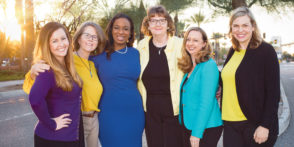How To Fill the Funding Tank
States plan for the future of highway funding
If you want to see the future of transportation, just look up.
So say futurists and science fiction fans. Obsessed with flight, they’ve long insisted that cars of the future will fly instead of drive. And they might be right: The Federal Aviation Administration (FAA) granted Amazon permission to use drones for package deliveries in August 2020, and German startup Volocopter in January 2021 applied to become the first FAA-approved operator of autonomous urban air taxis in the United States.
But don’t prepare for takeoff just yet. For now, at least, America still operates on asphalt instead of airstreams, according to the American Society of Civil Engineers (ASCE), which says highways and roads move 72% of U.S. goods—nearly $17 trillion worth of commerce every year.
Unfortunately, American roads aren’t just critical. They’re also crumbling. The ASCE gives them a ‘D’ on its 2021 Report Card for America’s Infrastructure. Over 40% of American roadways are now in poor or mediocre condition, reports ASCE, which says the average motorist wastes over $1,000 per year in time and fuel traversing deteriorating roads.
Highways need our help immediately, according to Oregon Department of Transportation (ODOT) assistant director of Revenue, Finance and Compliance Travis Brouwer, who blames the state of American roadways on a massive funding gap.
“Everybody uses the road system. And yet, most people don’t recognize the cost of maintaining it,” Brouwer says. “Over time, our funding streams have been compromised. And that means less money to keep the system in a state of good repair.”
The biggest strain on transportation coffers has been the deterioration and dilution of state and federal fuel taxes, according to AAMVA director of Government Affairs Cian Cashin. Fixing roads, he says, starts with fixing the taxes that fund them.
“Currently, we’re still reliant on the gas tax for the Highway Trust Fund, but that trust fund has been increasingly insolvent,” Cashin says.
Fortunately, a solution is starting to come into focus. And DMVs will play a significant role in executing it.
Fuel Taxes Are Running Out of Gas
Oregon established America’s first fuel tax in 1919. With automobiles becoming more popular, the state decided to tax gasoline at a rate of 1 cent per gallon to fund repairs to public highways.
The first federal gas tax came more than a decade later, when President Herbert Hoover signed the Revenue Act of 1932. The tax of 1 cent per gallon was intended to be a temporary measure to help the United States balance its budget during the Great Depression. Congress made it permanent during World War II, however, and eventually raised it to 3 cents per gallon in order to fund the Highway Trust Fund, which it established in 1956 to support the construction and maintenance of roads and bridges.
In its first year, the federal gas tax raised $124.9 million, or 7.7% of all federal revenue. Today, federal fuel taxes raise some $43 billion per year, or approximately 10% of all federal revenue. Collectively, state and local fuel taxes generate another $50 billion per year.
Although that sounds like a lot, it doesn’t go very far. “In Oregon and most other states, fuel taxes are not indexed to inflation,” Brouwer says. “So as costs go up across the economy, we have less buying power—we can buy less concrete and less rebar than we could in the past.”
One state that has tied its gas tax to inflation is California, whose Road Repair and Accountability Act of 2017, otherwise known as Senate Bill 1 (SB 1), raised state fuel taxes, established new motor vehicle fees, and indexed taxes and fees to the Consumer Price Index.
Unfortunately, even aggressive solutions like SB 1 might not be enough, according to Lauren Prehoda, a program manager at the California Department of Transportation (Caltrans). That’s because revenue from fuel taxes isn’t just weaker than it was in the past. It’s also smaller.
“Long term, we have other issues,” Prehoda says. “For one, gas-powered vehicles are becoming more fuel-efficient. That’s great on so many levels, but it means we’re buying less gas—and paying less in fuel taxes. Second, there’s the impact of electric vehicles, which do not pay the gas tax and in many states are paying no tax at all. So even if you increase the gas tax, there’s going to be a downward slope in revenue in the future as more people start driving electric vehicles.”
Mileage-Based User Fees Are the Future
Instead of reforming fuel taxes, policymakers have begun to examine ways of replacing them. The most likely alternative is mileage-based user fees, otherwise known as road usage charges.
“The idea is that individual vehicle owners would pay a per-mile fee for the use of the roadway, which is essentially what the gas tax is today,” says Kurt Myers, deputy secretary for driver and vehicle services at the Pennsylvania Department of Transportation (PennDOT). “The fewer miles you travel, the less you pay. The more miles you travel, the more you pay.”
While Pennsylvania is currently studying ways to implement a mileage-based user fee, California and Oregon are among a handful of states that already are experimenting with one. In 2017, the latter completed the first pilot of its Road Charge program, wherein drivers pay to maintain roads based on how much they drive instead of how much gas they purchase. While the initial pilot was a simulation to determine how the system might work, Caltrans is now preparing another pilot during which it will collect actual revenue.
Because they’re more equitable than fuel taxes, road usage charges are advantageous socially as well as fiscally, according to Prehoda, who oversees Road Charge. Under the gas tax system, she points out, people who have less fuel-efficient vehicles—older cars, for example, or work trucks—typically pay more than people who can afford new, more fuel-efficient vehicles, including hybrid and electric models.
“The nice thing about Road Charge is it’s fuel source-neutral,” Prehoda says. “It doesn’t matter what kind of car you have or what kind of fuel you’re using. Everyone pays the same to use the road.”
Oregon’s road usage charge program, OReGO, has been in operation since 2015, making it the nation’s first fully operable pay-per-mile system. For now, it’s purely voluntary. Eventually, however, it will likely be compulsory, according to Brouwer, who says drivers of fuel-powered vehicles receive a credit for fuel tax and remote emissions testing while drivers of electric vehicles are eligible for reduced registration fees.
Currently, participants track miles driven using a mileage reporting device that plugs into their vehicle’s on-board diagnostics (OBD) port. Although ODOT never receives or shares location data, devices are available with and without GPS tracking for users who have privacy concerns. And for motorists who don’t want a device at all, future iterations of the program might allow them to opt out by paying a flat annual fee, or to manually report their mileage by receiving regular third-party odometer checks.
“We’re seeing public support for this concept growing, particularly as people see more electric vehicles on the road,” Brouwer says. “People are starting to recognize that we need to be able to fund our transportation system in the future, and that this is a pretty fair way to do it.”
Destination: Interoperability
Among those recognizing the potential of mileage-based user fees are federal lawmakers, according to Jim Tymon, executive director of the American Association of State Highway and Transportation Officials (AASHTO). Last year, he points out, the landmark infrastructure bill—H.R. 3684, the Infrastructure Investment and Jobs Act—included two provisions designed to stimulate “strategic innovation for revenue collection.”
The first creates grant-based funding for local, state and regional pilot projects that will “test the feasibility of a road usage fee and other user-based alternative revenue mechanisms … to help maintain the long-term solvency of the Highway Trust Fund.” The second provides for the establishment of a national mileage-based user fee pilot program.
“Most states across the country have done the responsible thing and increased their revenue sources for transportation to match what they’re spending. The federal government has not. It hasn’t increased the federal gas tax for the last 25-plus years,” Tymon says. “This bill has some great programs that will help us finally take the next step in terms of how we fund our nation’s infrastructure in the future.”
Of course, mileage-based user fees have just as many challenges as advantages. Along with privacy concerns, for example, transportation officials must address issues like interoperability—how to track miles, share data and collect revenue when vehicles cross state lines—and enforcement: how and when to collect fees from motorists who are in arrears.
“It’s hugely complex, but I think there’s a willingness from partners on both sides of the fence—federal and state—to try and find novel solutions,” Cashin says. “There are certain aspects of the program that need to be [standardized]. They shouldn’t be so prescriptive as to limit participation, but they should make clear what a successful program looks like in ways that are applicable to any participating state.”
Some states already are collaborating on best practices. Both California and Oregon, for example, are part of RUC West, a consortium of 18 state transportation organizations that are sharing resources and knowledge around road usage fees. Pennsylvania, meanwhile, is part of the Eastern Transportation Coalition, a similar partnership among 17 states on the Eastern Seaboard.
Says Myers, “We’re years away from having a systematic, interoperable mileage-based user fee program. But states are taking steps to begin that journey, and we’re excited about it.”
DMVs Take the Wheel
DOTs aren’t the only ones strategizing and collaborating around mileage-based user fees. DMVs are doing the same.
“There’s no escaping the fact that the DMV will have to play an active role in the future of these programs,” Myers says. “Mileage-based user fees are going to require a lot of communication amongst departments and jurisdictions, and it’s fair to assume that much of that communication will be done by the DMV.”
States likely will delegate responsibilities to DMVs differently based on how their DMVs are structured and governed. Among other things, however, DMVs might be responsible for providing vehicle and driver data to program administrators, reporting road usage to motorists, and perhaps even tracking and collecting revenue.
“The DMV might run the program entirely, or it might run it jointly with the state tax agency or the state department of transportation,” Prehoda says. “There are a lot of different options, but the DMV is going to be involved at some level because the liability for road charges will be tied to VINs—and the database for VINs belongs to the DMV.”
Their roles might require DMVs to invest in new IT systems with which to collect, store and share road usage data; new personnel with which to administer their responsibilities; and new interfaces through which to engage the driving public.
“[Mileage-based user fees] may require an expansion of consumer and constituent interaction for DMVs,” explains Cashin, who says DMVs are largely focused on interacting with constituents when they need to perform a specific transaction, such as renewing their drivers license or registration. “Constituents are going to want more visibility into their records, including what they’re consuming in terms of vehicle miles traveled.”
For most DMVs, it will be the latest sea change in technology, governance and culture. It won’t happen overnight. But it has to happen quickly.
Concludes Cashin, “We need to figure out the policy implications immediately, because the writing is on the wall in terms of our ability to utilize the gas tax.”
For more information on the future of transportation funding, listen to our podcast here.




